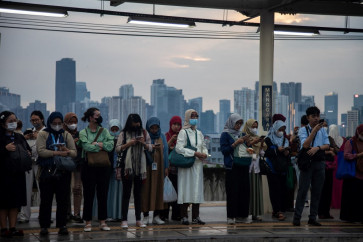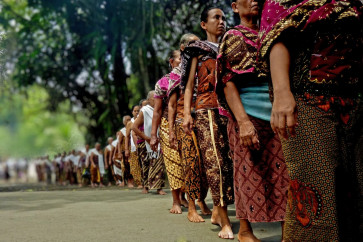Popular Reads
Top Results
Can't find what you're looking for?
View all search resultsPopular Reads
Top Results
Can't find what you're looking for?
View all search resultsPreserving batik with love
With care: A women carefully creates a piece of batik in Yogyakarta
Change text size
Gift Premium Articles
to Anyone
W
span class="caption" style="width: 398px;">With care: A women carefully creates a piece of batik in Yogyakarta. Antara/Wahyu PutroI used to think creating batik was as easy as drawing landscapes – until I tried my hand painting a simple motif when I attended “Adiwastra Nusantara 2011”, a regular cloth expo in Jakarta.
A mentor gave me and other batik enthusiasts a small piece of cloth to work on a prepared pattern. To laypeople, it looks easy when you watch artisans do it, but that day’s lesson convinced me that doing batik was challenging and tedious that only truly talented and dedicated people would take up the work as a profession.
Creating batik needs not only skills but also considerable patience and concentration to fully control the flow of the wax in the canting, a copper vessel resembling the bowl of a pipe filled with melted wax. That is why in past times batik-making was seen as a form of meditation.
It took me an hour to fill up my small piece of cloth with simple patterns, and it was amazing to see the batik artist produce a long cloth with intricate patterns and colors in the same amount of time.
The batik-drawing exercise was part of the expo organizers’ effort to introduce the art of batik-making to a wider audience.
For a great many years, batik has been on the decline, the indigeneous art form considered boring, formal and old-fashioned.
Tradition: A batik is created at the Danar Hadi Museum in Surakarta. JP/Anggit MaharaniBatik started losing shine in the middle of the 19th century with the beginnings of the westernization of fashion. The batik industry suffered because people switched to trendier clothing at the cost of the demure batik.
But, batik has been regaining its glory since UNESCO acknowledged batik as an Intangible Cultural Heritage on Sept. 30, 2009. Since then, batik has received great attention from the world community.
UNESCO’s recognition means that batik is Indonesian, and it shot down Malaysia’s claims to the art that has sparked popular protests some years ago. Indeed “batik” also exists in other part of the world. But Indonesian batik is much more than a piece of cloth with intricate drawings.
The indegenous “original batik” is hand-drawn (not the cheap machine-drawn printed batik widely available) with religious and Javanese philosophical symbolism embedded within it, and usually worn by royal families and servants.
Batik is inseparable from the life of Indonesian people through the centuries. The trend of wearing batik was popular from the 15th until the early 19th century. Batik was highly regarded at the time as a part of religious rituals.
People during those times, especially the Javanese, wore batik every day.
Recently, younger people born in the 80s and 90s have started to recognize the art. People have started wearing batik as part of their daily attire, uniforms and formal clothes. This trend is, of course, wonderful for the future of batik.
The government also made good headway by designating Oct. 2 as National Batik Day. The Australian-born Javanese cultural expert KRT Gaura Mancacaritadipura, who helps Indonesia promote batik to the international community, sees a bright future for batik.
Following UNESCO’s recognition, more serious efforts have been made to preserve and promote batik. For example, in Pekalongan – one of the country’s batik centers along with Yogyakarta and Surakarta – schools dedicate two to four hours of their regular week for students to learn to create batik. There, children are introduced to the art of batik at an early age.
Pekalongan University has been doing even better: It established a school of batik where students study every element of the art. Hopefully, this can inspire other regions to do the same.
In Yogyakarta, where batik is one of the aristocratic “high arts” along with gamelan and cultivated as a way to develop Javanese spiritual discipline, batik preservation has been taken seriously too.
There, traditional batik-making has been a major attraction for visitors – as a moneymaker. The famed Museum Batik Yogyakarta also offers short batik courses, enough to spark enthusiasts’ curiosity to learn more about the art.
It is also important that youths are involved in these preservation and promotion efforts. That is why schools have created batik uniforms that students must wear on certain days. Government offices and private companies have also recommended, or even made it obligatory, that employees wear batik on Fridays.
Break time: Batik makers gather at the Yogyakarta Palace. JP/Anggit MaharaniEfforts can begin with a simple activity: wearing batik every day. Not only that, we should innovate with our cultural heritage and make it fashionable.
More batik museums should initiate introductory courses for the public to get firsthand information and experience with batik. Only serious efforts will ensure that the tradition will continue to be handed down to our offspring.
Today, many creative designers make batik beautifully and simply, with a great array of motifs to choose from.
And, batik can be appropriate for all occasions, formal and informal. Nowadays, we can find batik gracing everything from hats, shoes and bags to keychains.
Now, to say batik is too formal or unfashionable is what is outdated.












